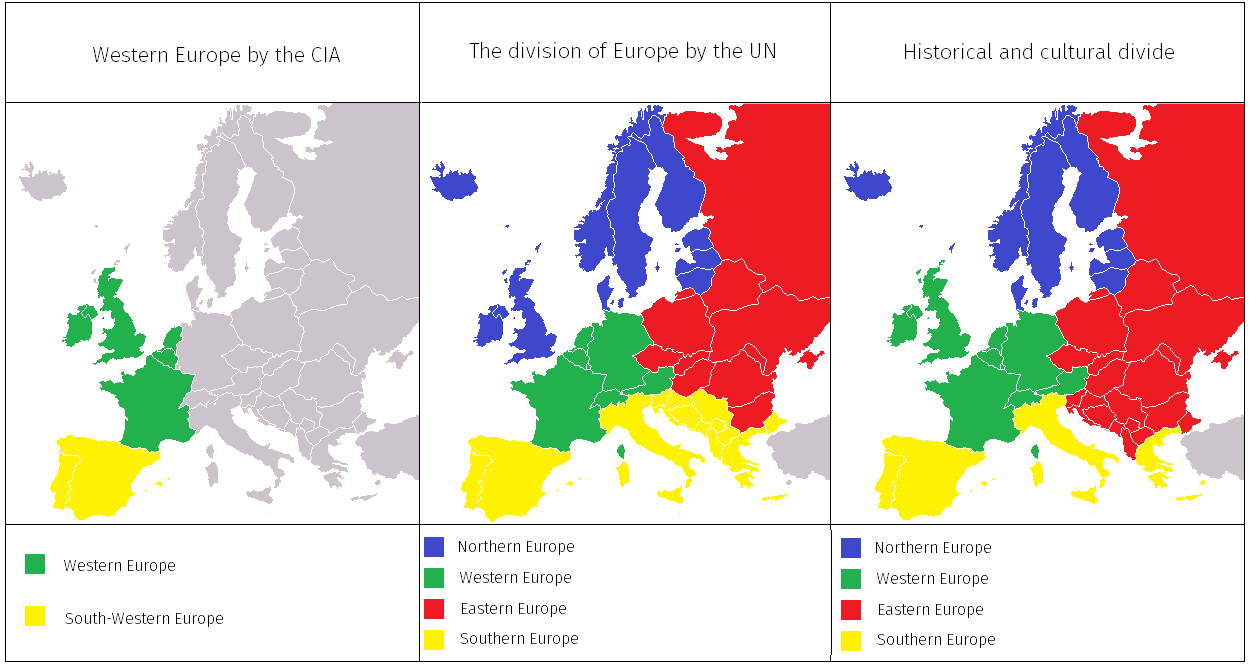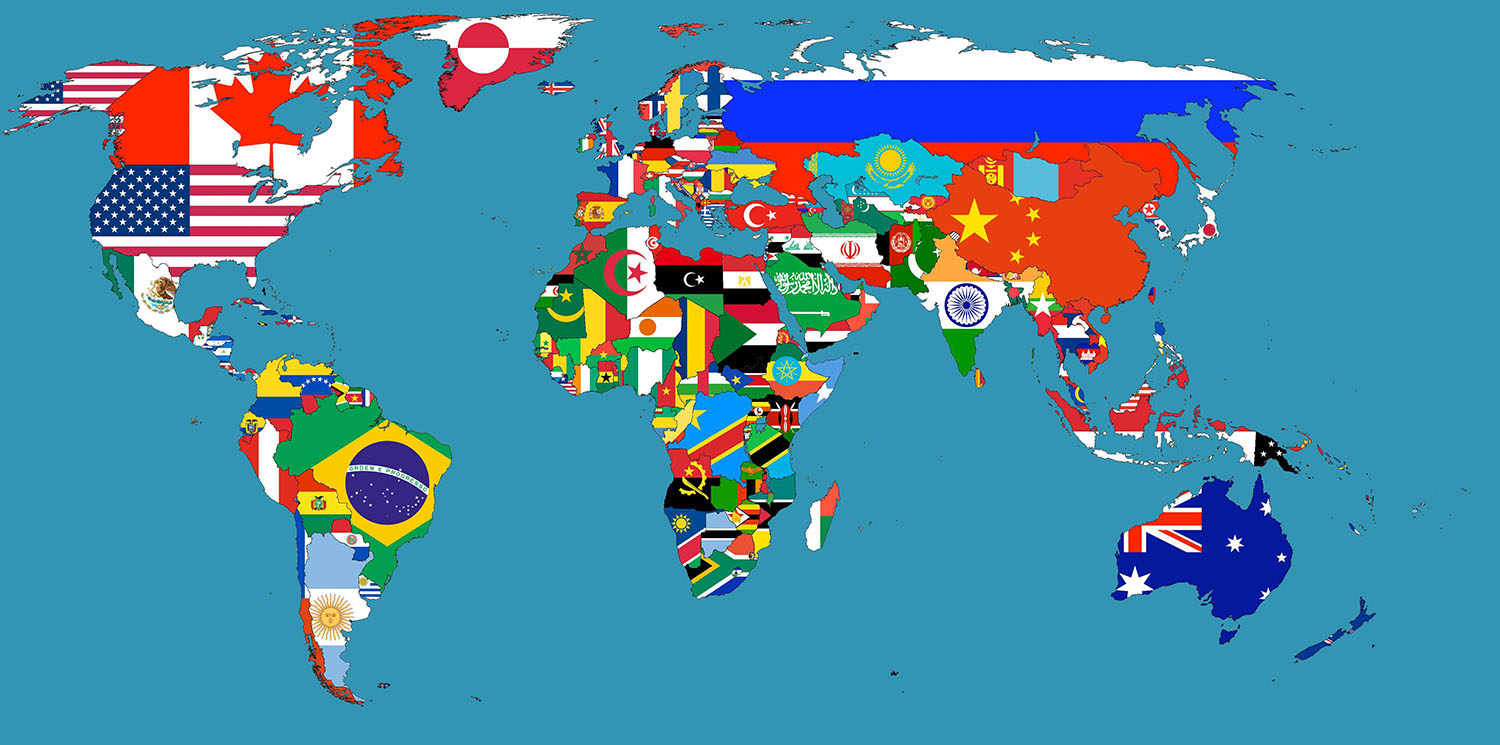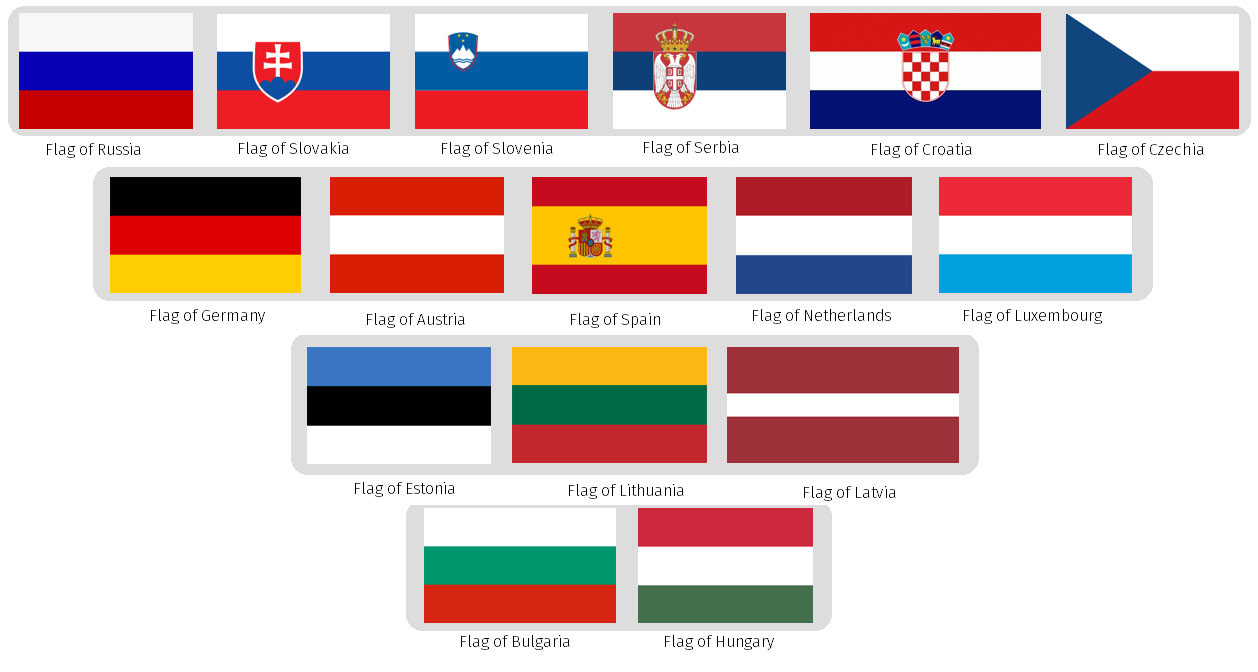Europe has 45 independent states, each of which has its own social and political specificity which largely depends on the region of this part of the world. This is why zoning of European territories is important. In this issue (as in many others) experts do not concur. So, the division into sub-regions was largely dependent on the time when the issue was discussed, on political motives, economic development and the like.


The division of the European countries into sub-regions
Of course each of these divisions carries a certain sense. In each of these maps the division was carried out by a particular parameter or even a number of parameters. Thus, any map according to this parameter is used for different purposes. Many maps are also being created solely for the aesthetical or presentational purposes. For example this one:

Map of the world flags
However, this map has an obvious drawback — it lacks visibility, as small countries are lost on such scale, flags of neighboring countries merge and so on. In any case in this article we are going to discuss only one part of the world — Europe.
It is clear that each country is a separate world with its own culture, natural environment, history and language. But often the research on the country which we have never been to starts with the flag. This distinguishes it from other symbols of the country — the coat of arms and the anthem. This is why it is not just a “colored cloth”, recognized by the state and the citizens. A flag is the most important distinctive symbol of the country which emphasizes the importance of its achievements, history, nature and culture. It is also the reason why the choice or change of the national country flag often generates a lot of debate. It is a known tradition to place a flag at a conquered place and mankind did even get to the Moon with its flag.

Buzz Aldrin welcomes the first American flag, placed on the Moon on 21 July 1969
Well, the more important the role of the flags in the history of mankind is, the more interesting it will be to look at the map of European regions which will be selected according to the type of flag, considering the fact that there are distinctive features which make it possible to form groups. In this case we shall consider the most competent and logical division in accordance with the design of the flag and will try to create an appropriate map.
The Nordic Cross
The first group includes flags that are based on the Christian cross which is also called the “Scandinavian” because of the geographical location of countries using this symbol.
Traditionally, the vertical line shifts towards the flagpole, on top of which a cross is installed. It is noteworthy that the oldest flag (approved 15 June 1219) is still in use in Denmark and is called the “Dannebrog”. Thus, flags of this group symbolize the dominant European religion — Christianity and also carry a historical and cultural value.

Modern flags which use the Scandinavian cross
This group can be expanded by flags of different nations, cities, former states and other modern territories, but let’s consider only the flags of the states. Belarus, Estonia, Germany, Lithuania and other countries at a time wanted to use the Scandinavian cross, however, due to various reasons, these flags were not approved.

Other countries which could use the Nordic cross
Thus, countries that use the Scandinavian cross are denoted in blue:

Map of countries with the Scandinavian cross
Bicolor With Horizontal Division
Despite the simplicity, the number of countries which use this type of flag is relatively small not only in Europe but also in the world. There are only four bicolors with horizontal division currently. They are used by Indonesia, Monaco, Poland and Ukraine (three European states respectively). Polish and Ukrainian are known since the Battle of Grunwald, but the flag of Monaco was adopted later — in 1881. It is interesting that this flag was the subject of a diplomatic conflict with Indonesia as both flags are 100 % identical even today. But since the Indonesian flag is older, none of the parties changed their flag.
Let’s also add as a subgroup bicolors with horizontal division with coat of arms: the flag of Liechtenstein and San Marino. In the first case the flag was purely bicolor, but in 1936 there was a conflict with Haiti as the flags were completely identical. The situation was resolved by placing a crown closer to the flagpole. This design of the flag is used today.
Flag of San Marino in its civilian version is also a clear bicolor. One can add to this group the Belarusian flag, however the color division is not equal and there is a pattern by the flagpole. We would also like to discuss the Belarusian flag in another article and that is why it will be placed in the horizontal bicolors group.

The current flag of Belarus

Modern flags which use bicolor with horizontal division
Let’s add the countries which use this type of flag and color them in red:

Map of flags with Scandinavian cross and horizontal bicolors
Bicolor With Vertical Division
I decided to include three flags in this group: Portuguese, Maltese and Vatican. Although the latter two use the coat of arms, it is not critical, but the Portuguese flag is more complicated. Historically the flag had a cross and was mono-colored. It later became a bicolor and currently has a rather non-classified form. Nevertheless, the history of the flag as well as its modern look, allow us to relate it to this category.

Modern bicolors with a vertical division
Let’s add them to the map:

Map of Scandinavian flags, horizontal and vertical bicolors
Horizontal Tricolor
It is time to analyze the largest group. These flags are being used by fifteen European states (if we count in Spain, whose flag consists of two equal red stripes which have a yellow stripe twice as large as the other two).
One of the first tricolors was the flag of the Republic of the Seven United Provinces:

Prince’s Flag
Such a large group can be easily divided into sub-groups due to color diversity. Let’s distinguish these subgroups:
- Pan-Slavic group (mainly used: blue, white and red): Russia, Serbia, Slovakia, Slovenia, Croatia, Czechia. The Czech tricolor has a peculiar color division but nevertheless it is still a tricolor.
- Western European group (mainly: red, blue, yellow and white colors): Austria, Germany, Span, Luxembourg, the Netherlands.
- Baltic group: Latvia, Lithuania, Estonia.
- Eastern European group (used: green, red and white colors): Bulgaria, Hungary.

Modern tricolors with horizontal division
Of course, the factor of historical origins and traditional division was used while creating the subgroups. Otherwise, the flags of the Netherlands and Luxembourg would be logical, according to the color, to relate to the Pan-Slavic group, however, it is intuitively and historically inaccurate. It is even conceivable that the red and white in the Dutch and the Luxembourg’s flags are not equal to the red and white in the East Slavic group and represent other events, things and feelings.
Let’s add horizontal tricolors on our map:

Map of flags with Scandinavian cross, horizontal tricolors, horizontal and vertical bicolors
Vertical Tricolor
Seven states have this type of color arrangement, two of which have their coat of arms on the flag. The very first vertical tricolor appeared on the banners of France. Thus, even in the Middle Ages blue and red colors were popular among the kings and monarchs of this country. However, the flag was recognized in its current form only in 1794.

Modern tricolor flags with vertical division
Adding them to the map:

Map of flags with Scandinavian cross, horizontal and vertical tricolors and bicolors
One-Color Flags With the Coat of Arms
We will put Albania, Montenegro and Switzerland in this group. The current flag of Montenegro is relatively young — recognized in 2004 (the flag was a red-blue-white tricolor before). Swiss’s flag is notable for its square shape and also that it is considered to be the prototype of the flag of the Red Cross.

Modern one-color flags with the coat of arms
Adding them to the map:

Map of flags with Scandinavian cross, one-color flags, horizontal and vertical tricolors and bicolors
Others
This category includes flags that were difficult to attribute to any of the previous groups. In fact, each of these flags is a separate group, but for convenience reasons let’s combine them here. Other countries: Bosnia and Herzegovina, United Kindgom, Greece, Kosovo and Macedonia.
Flag of Macedonia, which consists of two colors, represents the “new sun of liberty”. Flag of the United Kingdom is called the “Union Jack” and its history is traced to 1603. Flags of Bosnia and Herzegovina and Kosovo are relatively young — they were approved in 1998 and 2008 respectively.

Modern flags of special coloring
Adding them to the map:

Map of European types of flags
That is it, the zoning is over. Now we can take a look and draw some conclusions. Of course this map looks a bit strange as it unites the countries not on usual historical, geopolitical or cultural aspects but by the design of the national flag. Nevertheless, I believe that this map is interesting to explore. In addition, certain conclusions can be made.
Under the influence of the Christian religion flags with the Scandinavian cross were created. The tricolor is very popular, especially with the horizontal division. The most common basis for the tricolor flags were the colors of the king’s flags, revolutionaries or the country’s lands. The two-colored flags did not gain much popularity, even though they were adopted in a number of Eastern European countries. Monochrome flags also proved unpopular. With regard to island and coastal states, they expressed an interest in peculiar flags which are difficult to categorize.
The flag represents the country’s culture. Someone believes that there should be more diversity in the state symbols, others like the current state of affairs. In any way the culture of flags is incredibly rich and that is why it is worth paying attention to it. We shall discuss flags of other parts of the world in the following articles.



























Comments